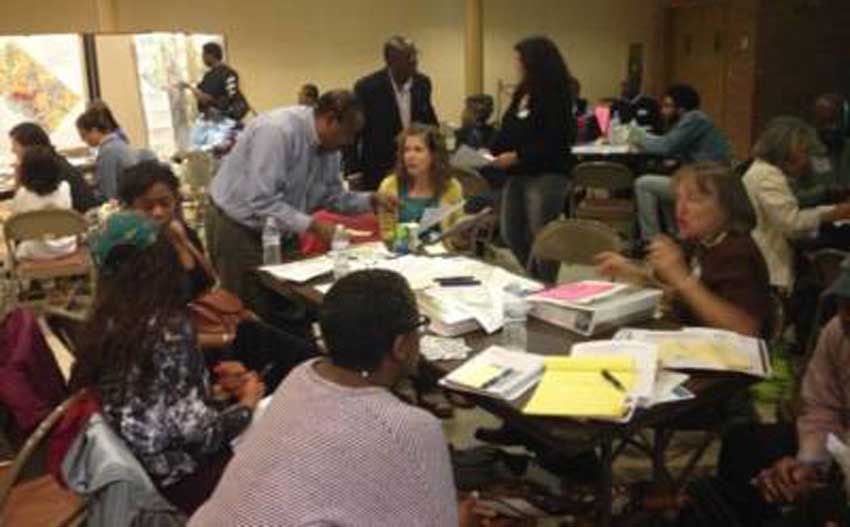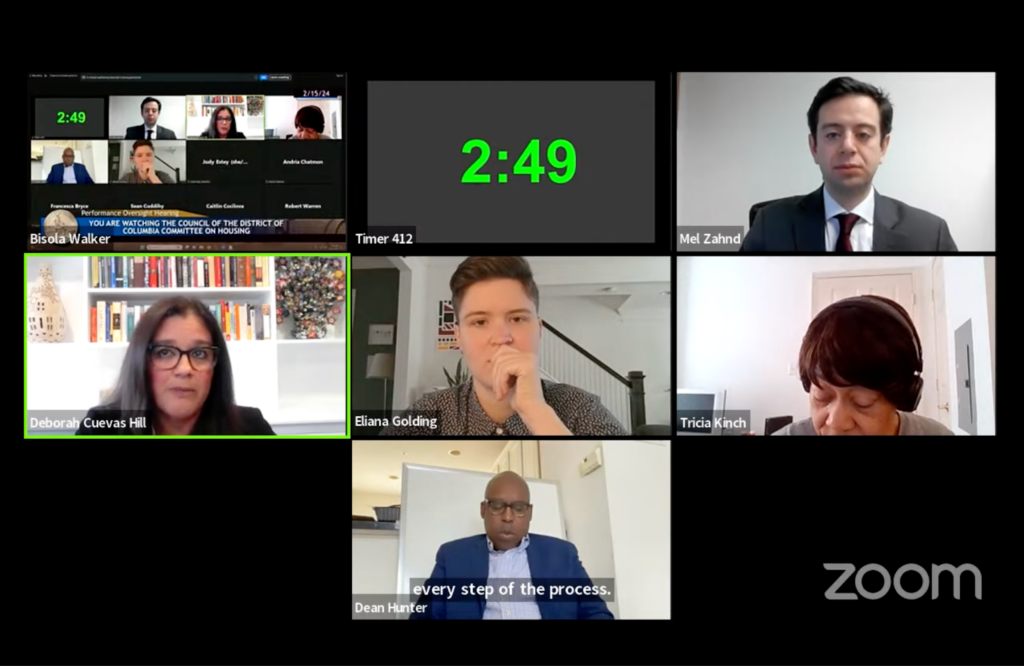Housing experts, nonprofit leaders and concerned citizens attended a series of workshops hosted by the nonprofit advocacy group Empower D.C. to discuss sections of the city’s 20-year Comprehensive Plan to guide land use and development, which is being updated. Participants were grouped at tables by ward for discussions, which were often intense. Based on sign-in lists, about 100 people attended the workshops.
Empower D.C. has been compiling notes of the meetings and will present those notes to the D.C. Council in June. Due to high interest, the deadline for accepting public input was extended by nearly a month to June 23.
People at the meetings agreed that all who live in the District need to be able to afford a roof over their head, regardless of their income — a concept housing advocates call “universal housing.” But the city’s affordable housing policy is not grounded in the most relevant data. Instead, housing policy uses Area Median Income as a metric. And AMI is based on incomes of residents of the greater D.C. metro area, which includes Montgomery County, Maryland, and Fairfax County Virginia — two of the richest counties in the country. As a whole, District resident are not as wealthy as residents of Montgomery or Fairfax Counties. And in 2015, D.C. was heralded as having a greater income disparity than any state in the country. So the median, especially a regional figure, skews higher than the average income of District residents.
The current comprehensive plan’s affordable-housing model says that one-third of all new housing unit production must be reserved for those at 80 percent or less of AMI. But D.C. renters with incomes approaching 80 percent of AMI do not have the same dire need for housing assistance as D.C. residents at the lower end of the scale, those with incomes at 0-30 percent and 30-50 percent of the AMI. The absolute numbers of individuals at the lower end of the scale is unknown to housing officials, but thought to be significant. A 2016 D.C. Fiscal Policy Institute Report claimed that the vast majority of households – 89 percent – have incomes below $32,100 for a family of four: 30 percent of the area median.
Nor is it known how vouchers that make low-cost housing available to those with little funds impact affordable housing. Forty percent of existing housing stock is single-family housing, officials said. Advocates called for calculating housing information by ward, not by the immediate neighborhood. Housing advocates at the Empower D.C. meetings also emphasized the lack of precise information on how much affordable housing stock has been produced vs how much affordable housing has been lost.
Eric Sheptock, an affordable-housing advocate, and Melissa Millar, the director of policy and advocacy for Community of Hope, noted that private developers are not required to follow two important housing-fairness laws. The Davis–Bacon Act, a federal law, requires that contractors who receive federal funding pay their workers at least a living wage; and the District’s First Source law requires contractors doing business here must hire a certain number of D.C workers for their projects.
Another important focus at the input meetings was economic development, related to both education and job training as well as increasing job opportunities. Meeting attendees agreed that to afford housing, people need to be able to get jobs. So-called Supported Training in advance of new development projects, especially those in the poorer wards, would be useful.
It was also suggested that “sweat equity” requirements — apprenticeship programs that hire and train workers who would benefit from a housing project to work on that project, could be put into developers’s contracts. The District successfully implemented a sweat-equity pilot program in 2013. Several attendees noted the logic behind this program model and the return on investment for developers. A person needs a job and a place to live – he or she works with a developer to build a building, moves in, and retains his employment with the developer on additional projects.
People at the meetings focused on the need to attract jobs to wards 7 and 8. Retail and service establishments could be co-located with mixed-income housing.
It was emphasized that affordable housing availability needs to be ensured all across the city. And many participants called for designations of neighborhoods such as “stable” or “emerging” to be removed — placing equal value, expectation and investment on all residential areas.
Of particular significance, meeting participants agreed that redevelopment of public land, such as vacant parcels or existing District-owned buildings, as well as exercise of eminent domain by the District for abandoned or blighted properties can and should be used for redevelopment into affordable housing. A bill to this effect, the Property Rehabilitation for Affordable Housing Act of 2016, has been introduced by D.C. City Council members Anita Bonds, Council Chairman Phil Mendelson, as well as Councilmembers Grosso, Nadeau and Silverman.
Increasing relative densities throughout District neighborhoods to ensure affordable housing availability in each ward for people of various income levels, backgrounds and educational levels, is important, attendees agreed in the compiled meeting notes. Encouraging development around transit such as Metro allows higher density. Meeting attendees said they want all transit corridors “on the table” for consideration for development. They called for places where “there is the greatest opportunity for infill and growth” not to be singled out because doing so will also further concentrate affordable housing in certain areas.
Moving on, meeting attendees called for recent housing projects with high densities brought into use within the past few years to be reviewed. Sheptock called for particular attention to be paid to how many projects there are and how many are done, as well as how many affordable units each delivers. Also, he called for monitoring how many acres of the city’s developable land have been given up and how many are remaining.
The current figures troubled participants. Sheptock said 60,000 units renting for $800 or less were available a decade ago. At most, 32,000 of those remain.
That means almost 30,000 affordable units have been lost.
Attendees agreed that the Comprehensive Plan must predict how many projects will be needed. That is a figure that the District government should monitor in assessing its population’s needs, he added. Basically, is available affordable housing keeping pace with residents’ needs? Developers also need to be pressed about how many affordable units they’re delivering and at what price ranges — compared to what working District residents are actually able to earn.
Sheptock added that U.S. Department of Housing and Urban Development governing statute indicates that policy should “affirmatively further(ing) fair housing.” Significantly, that language makes no mention of clustering housing around Metro stations, as has been done around here for years.
According to the meeting notes, many attendees suggested that D.C. government should re-word zoning language to more clearly define mixed-use development guidelines and allow the flexibility to formally change commercially or industrially-zoned land to residential, or vice-versa.
Housing is a universal human right, meeting attendees agreed, referencing the United Nations Universal Declaration of Human Rights. Sheptock and others proposed declaring the current situation a “state of emergency” to help expedite permitting, financing, zoning review and other steps in the process.
A number of attendees agreed also that tax incentives alone are not sufficient. Three proposed options for ensuring long-term commitments to affordable housing such as giving out project-based vouchers and providing master leases that would agreeing to house people for less rent by use of tax credits under Schedule H.
Rent control is critical and needs to be strengthened, all agreed. All said that the periods of time rent control is in effect needs to be increased. Sixty percent of D.C.’s residents are renters.
Housing discrimination against renters has already been shown to happen, several experts noted in the compiled notes, especially against voucher holders.
The notes also called for a new task force on affordable housing to be put in place that would include representatives and stakeholders from government, advocacy organizations and private citizens.
A neighborhood impact statement for new developments was suggested, which would include transparency on the amount of money a developer is making on the project and how much rent they are charging.
Importantly, a better definition of “affordable housing” was called for. Rather than the regional AMI approach, meeting attendees suggested that a District-specific AMI needs to be calculated to ensure that the prices of housing units here match the incomes of D.C. employees and residents.
The next Empower D.C. community input meeting is scheduled for noon on Saturday, June 10 — location to be determined. More information on the plan, the amendment process and how to submit feedback directly is available at https://plandc.dc.gov/.








